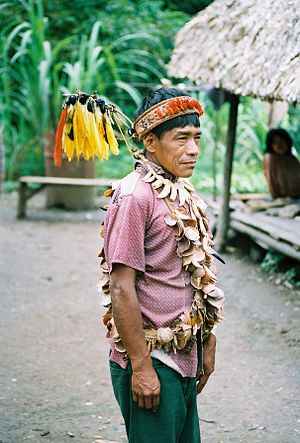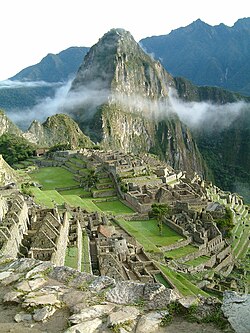Peru
Peru is a country in South America. The capital is Lima. The ruins of Machu Picchu, the Andes mountains, and the source of the Amazon River are all found in Peru.
Republic of Peru | |
|---|---|
| Motto: | |
| Anthem: | |
 | |
| Capital and largest city | Lima 12°2.6′S 77°1.7′W / 12.0433°S 77.0283°W |
| Official languages | Spanish (Peruvian) |
| |
| |
| Ethnic groups | List of ethnic groups
|
| Religion | List of religions
|
| Demonym(s) | Peruvian |
| Government | Unitary presidential constitutional republic[1][2]under semi-presidential system |
| Dina Boluarte | |
| Alberto Otárola | |
| Legislature | Congress of the Republic[4] |
| Independence from the Kingdom of Spain | |
• Declared | July 28, 1821 |
| December 9, 1824 | |
• Recognized | August 14, 1879 |
| Area | |
• Total | Lua error in Module:Convert at line 1850: attempt to index local 'en_value' (a nil value). (19th) |
• Water (%) | 0.41 |
| Population | |
• 2020 estimate | |
• 2017 census | 31,237,385 |
• Density | Lua error in Module:Convert at line 1850: attempt to index local 'en_value' (a nil value). (198th) |
| GDP (PPP) | 2020 estimate |
• Total | |
• Per capita | |
| GDP (nominal) | 2020 estimate |
• Total | |
• Per capita | |
| Gini (2017) | ▼ 43.3[7] medium |
| HDI (2018) | high · 82th |
| Currency | Sol (PEN) |
| Time zone | UTC−5 (PET) |
| Date format | dd.mm.yyyy (CE) |
| Driving side | right |
| Calling code | +51 |
| ISO 3166 code | PE |
| Internet TLD | .pe |
Peru is bordered to the north by Ecuador and Colombia, to the east by Brazil, to the south by Chile, and to the southeast by Bolivia. Peru is a representative democratic republic divided into 25 regions and over 33 million people live in it.
Peruvian territory was home to the Norte Chico civilization, one of the oldest in the world, and to the Inca Empire, the largest state in Pre-Columbian America. The Spanish Empire conquered the region in the 16th century and established a Viceroyalty, which included most of its South American colonies. After achieving independence in 1821.
Peru suffered a terrible guerrilla war in the 1980s. The communist (Maoist) Shining Path tried to take over the country. But after the leader of the group was captured in 1992, Shining Path was not a threat anymore. During the 1990s, it was ruled by President Alberto Fujimori. During this time, the economy of Peru got better, and it became easier to start a company or operate a business. After Fujimori, Alejandro Toledo was elected president, and then Alan Garcia, who was president from 1985 to 1990, was elected again in 2006. Ollanta Humala was elected president in 2011 and Pedro Pablo Kuczynski was elected president in 2016. In March 2018, Kuczynski resigned following political scandals and Vice President Martín Vizcarra was sworn in as the next president.
Peru's most important exports, products that it sells to other countries, are fish, gold and other metals, oil, coffee, sugar, and cotton. Also, the food in Peru is very diverse, including typical dishes like Ceviche and Broiled Chicken.
Tourists from other countries like to come to Peru because of the history and also to enjoy nature. Many people come to climb mountains in the Cordillera Blanca in the Ancash Region, and many people visit Peru's long Pacific coast or the Amazon jungle. Cuzco and Machu Picchu are just two of the places where many buildings built by the Incas are still standing after hundreds of years, and these are some of the most visited places. The Incas were not the only tribe in Peru who left buildings and artifacts, but they were the most powerful.
Peru is divided into 25 regions of Peru regions. Lima is the capital and other main regions are Cuzco, Arequipa and Lambayeque.

In the Amazon jungle region, we can find many important rivers and different animals, plants and people of many indigenous cultures.
Peru includes 29.5 million people.
The currency of Peru is the Nuevo Sol.
Demographics
The population of Peru is approx. 30 million. The ethnic composition of Peru is like the following:
Economy
As of 2018, about 22.3% of the population lives below the national poverty line[9]
History
Peru was the home of the Inca Empire. The Incas were a well-organized Indian civilization that began the city of Cuzco (now called Cusco).[10] Beginning in the 1400s, they defeated many nearby tribes and built an empire in the Andes. The Inca forced the people to work for the king for a certain number of days every year. They used this "work tax" to build roads and terraces on the sides of the mountains to grow crops, and huge cities with rich palaces for the rulers and their queens. Records were kept on quipa, knotted ropes, since the Incas never invented writing. These could be quickly sent anywhere in the empire by a series of relay runners set up along the roads. Heavier loads were sent by llamas, the pack animals of the Andes.[10] The Incas were rich in gold and silver which could be found in the mountains. The Spanish wanted that treasure when they discovered the nation in the 1500s. Francisco Pizarro, a Spanish man, kidnapped and killed the Inca ruler in 1532, even after his people paid a huge amount of treasure for his release. The Incas fought the Spanish for many years, but the last Inca king was killed in 1572. Peru was a Spanish colony until 1821. Spanish is still the main language of the people, although many also speak Quechua, the Inca language.[10]
Peru Media
The peruvian national anthem performed by the United States Navy Band. Converted from MP3 to OGG.
March of Flags
Remains of a Caral/Norte Chico pyramid in the arid Supe Valley
Moche earrings depicting warriors, made of turquoise and gold (1–800 CE)
Related pages
References
- ↑ Shugart, Matthew Søberg (September 2005). "Semi-Presidential Systems: Dual Executive and Mixed Authority Patterns" (PDF). Graduate School of International Relations and Pacific Studies. Archived from the original (PDF) on August 19, 2008. Retrieved August 31, 2017.
- ↑ Shugart, Matthew Søberg (December 2005). "Semi-Presidential Systems: Dual Executive And Mixed Authority Patterns". French Politics. 3 (3): 323–351. doi:10.1057/palgrave.fp.8200087. ISSN 1476-3427. OCLC 6895745903.
Only in Latin America have all new democracies retained a pure presidential form, except for Peru (president-parliamentary) and Bolivia (assembly-independent).
- ↑ Kurmanaev, Anatoly; Andrea Zarate, Andrea (September 30, 2019). "Peru's President Dissolves Congress, and Lawmakers Suspend Him". The New York Times. Retrieved October 2, 2019.
- ↑ Constitutionally dissolved until a new election in January 26, 2020.[3]
- ↑ "Perú: Estimaciones y Proyecciones de Población Total, por Años Calendario y Edades Simples, 1950–2050" [Peru: Estimates and Projections of Total Population, by Calendar Years and Simple Ages, 1950-2050] (PDF) (in Spanish). National Institute of Statistics and Informatics. September 2009.
{{cite web}}: CS1 maint: unrecognized language (link) - ↑ 6.0 6.1 6.2 6.3 "Peru". International Monetary Fund.
- ↑ "Gini Index". World Bank. Retrieved April 6, 2019.
- ↑ "2019 Human Development Report" (PDF). United Nations Development Programme. 2019. Retrieved December 9, 2019.
- ↑ "Peru Poverty Rate 1997-2021". www.macrotrends.net. Retrieved March 31, 2021.
- ↑ 10.0 10.1 10.2 K. Buskey, Theresa (March 2001). LIFEPAC, History and Geography. Alpha Omega Publications. p. 34. ISBN 978-1-58095-155-5.
Notes
- ↑ 1.0 1.1 In Peru, other languages have been officially recognised as legitimate autochthonous languages. In each of these, Peru's official name (Spanish: República del Perú, pronounced: [reˈpuβlika ðel peˈɾu]) is as follows:
- ↑ The 2017 National Census included, for the first time, a question of ethnic self-identification that was addressed to people aged 12 and over considering elements such as their ancestry, their customs and their family origin in order to visualize and better understand the cultural reality of the country.
- ↑ The question about religion included in the 2017 National Census was addressed to people aged 12 and over.
Other websites
- Peruvians in Germany Archived 2008-06-23 at the Wayback Machine
- Peruvian Directory of websites


